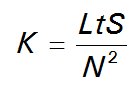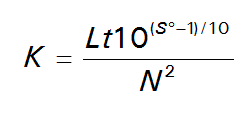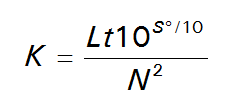Doug Kerr
Well-known member
ISO standard 2720 gives the requirement for "free-standing" photographic exposure meters. It has many curious things, but perhaps the most curious is a serious outright gaffe in the mathematics, leading a a bizarre provision of the specifications.
With regard to reflected light metering, the photographic exposure recommended by the meter is to be in accordance with this, the incident light exposure metering equation:

where t is the exposure time (shutter speed), N is the f-number of the aperture, S is the exposure index (as the ISO speed), L is the measured luminance of the scene, and K is a parameter, the reflected light metering calibration constant. By choosing a value of K, the manufacturer of the meter determines what exposure recommendation he wants the meter to give for any given scene luminance and exposure index.
At the time ISO 2720 was issued, the sensitivity of film could be stated in two ways: one was on the familiar "arithmetic" scale (e.g., ISO 100) and the other was on the "logarithmic" scale (e.g., ISO 21°), which in fact corresponded to the earlier DIN scale.
The two forms are related this way:

This is of course consistent with the well-known relationship between the two scales:
Thus we could substitute that relationship into the first equation and get the reflected light metering equation in a form that uses the logarithmic expression of the exposure index, S° (I won't trouble you by actually doing that, although, if this spoils the story for you, Tom, let me know, and I'll provide it in a supplement to this note.)
Now to the gaffe. ISO 2720 actually provides for two forms of K, one (K1) to be used in the exposure metering equation in terms of the linear form of the exposure index, S, and another (K2) to be used in the exposure metering equation in terms of the logarithmic form of the exposure index, S°. And the standard provides that for any decision made as to the value of K for a particular meter design:
But having set the exposure index (by way of either value), the meter then would exhibit a certain behavior, which is characterized by the value of K. It is absurd to think of this one meter having two different values of K, depending on whether I considered myself to have set the exposure index to ISO 100 or to ISO 21°. The meter had no idea in what form of the exposure index I was working. It was set to ISO 100/ISO 21°.
This bizarre situation resulted in the authors of the standard having based their work on an erroneous understanding of the relationship between the arithmetic and logarithmic scales for the film sensitivity, namely this:
 THIS IS WRONG
THIS IS WRONG
This then led to a wrong exposure equation in the form that works from S°.
Then, when trying out the two forms of the equation with for example, ISO 100 and ISO 21°, they noticed that the exposure results for any given luminance differed by a factor of about 1.26. (That is 10^(1/10), the result of the lost "-1".)
So to fix that, they provided for different values of K, K1 and K2, for the two "situations"! They plugged it.
There is an exactly parallel situation for the incident light metering equation(s), whose parameter is C.
That's all pretty revolting.
Best regards,
Doug
With regard to reflected light metering, the photographic exposure recommended by the meter is to be in accordance with this, the incident light exposure metering equation:

where t is the exposure time (shutter speed), N is the f-number of the aperture, S is the exposure index (as the ISO speed), L is the measured luminance of the scene, and K is a parameter, the reflected light metering calibration constant. By choosing a value of K, the manufacturer of the meter determines what exposure recommendation he wants the meter to give for any given scene luminance and exposure index.
At the time ISO 2720 was issued, the sensitivity of film could be stated in two ways: one was on the familiar "arithmetic" scale (e.g., ISO 100) and the other was on the "logarithmic" scale (e.g., ISO 21°), which in fact corresponded to the earlier DIN scale.
The two forms are related this way:

This is of course consistent with the well-known relationship between the two scales:
ISO 21° is the same as ISO 100
Thus we could substitute that relationship into the first equation and get the reflected light metering equation in a form that uses the logarithmic expression of the exposure index, S° (I won't trouble you by actually doing that, although, if this spoils the story for you, Tom, let me know, and I'll provide it in a supplement to this note.)
Now to the gaffe. ISO 2720 actually provides for two forms of K, one (K1) to be used in the exposure metering equation in terms of the linear form of the exposure index, S, and another (K2) to be used in the exposure metering equation in terms of the logarithmic form of the exposure index, S°. And the standard provides that for any decision made as to the value of K for a particular meter design:
K2 = 1.26 K1
Now this seems awfully strange. In reality, most exposure meters of the era could allow you to set the exposure index either in terms of the "arithmetic" scale (perhaps to ISO 100) or the "logarithmic" scale (to ISO 21°), typically by bringing the number wanted into one of two little windows. Of course the two scales were linked together by the relationship given above - if one set 100 in the "ISO" window, then 21 would appear in the "ISO° window.But having set the exposure index (by way of either value), the meter then would exhibit a certain behavior, which is characterized by the value of K. It is absurd to think of this one meter having two different values of K, depending on whether I considered myself to have set the exposure index to ISO 100 or to ISO 21°. The meter had no idea in what form of the exposure index I was working. It was set to ISO 100/ISO 21°.
This bizarre situation resulted in the authors of the standard having based their work on an erroneous understanding of the relationship between the arithmetic and logarithmic scales for the film sensitivity, namely this:

This then led to a wrong exposure equation in the form that works from S°.
Then, when trying out the two forms of the equation with for example, ISO 100 and ISO 21°, they noticed that the exposure results for any given luminance differed by a factor of about 1.26. (That is 10^(1/10), the result of the lost "-1".)
So to fix that, they provided for different values of K, K1 and K2, for the two "situations"! They plugged it.
There is an exactly parallel situation for the incident light metering equation(s), whose parameter is C.
That's all pretty revolting.
Best regards,
Doug



